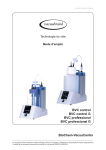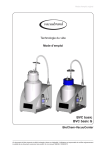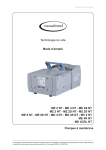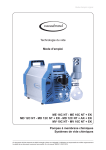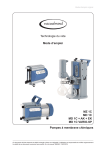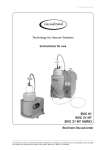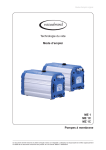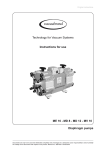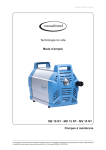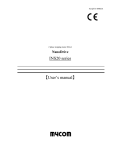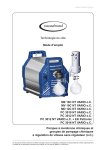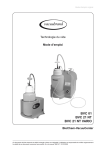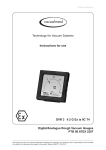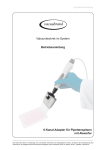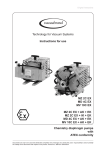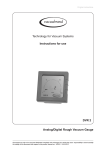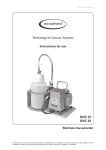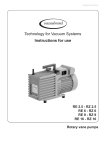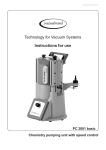Download - Vacuubrand.com
Transcript
page 1 of 68 Technology for Vacuum Systems Instructions for use BVC control BVC control G BVC professional BVC professional G BioChem-VacuuCenter page 2 of 68 Dear customer, Your VACUUBRAND diaphragm pumps are designed to provide you with many years of trouble-free service with optimal performance. Our many years of practical experience allow us to provide a wealth of application and safety information. Please read these instructions for use before the initial operation of your pump. VACUUBRAND diaphragm pumps combine our many years of experience in design, construction and practical operation, with the latest developments in material and manufacturing technology. Our quality maxim is the ”zero defect” principle: Every diaphragm pump, before leaving our factory, is tested intensively, including an endurance run of 14 hours. Any faults, even those which occur rarely, are identified and can be eliminated immediately. After completion of the endurance run, every pump is tested, and must achieve specifications before shipment. We are committed to providing our customers only pumps that meet this high quality standard. While our pumps cannot eliminate all of your work, we design, manufacture and test them to ensure that they will be an effective and trouble-free tool to assist you in that work. Yours, VACUUBRAND GMBH + CO KG After sales service: Contact your local dealer or call +49 9342 808-5500. Trademark index: VACUU•LAN® (US-Reg.No 3,704,401), VACUU•BUS®, VACUU•CONTROLTM, chemistry-HYBRIDTM, Peltronic®, TURBO•MODETM, VARIO® (US-Reg.No 3,833,788), VARIO-SPTM, VACUUBRAND® (US-Reg.No 3,733,388) and also the shown company logos are trademarks of VACUUBRAND GMBH + CO KG in Germany and/or other countries. page 3 of 68 Contents Safety information!.........................................................................4 Important information!....................................................................................... 4 General information........................................................................................... 6 Intended use..................................................................................................... 6 Setting up and installing the system.................................................................. 7 Ambient conditions............................................................................................ 8 Operating conditions......................................................................................... 9 Safety during operation................................................................................... 10 Maintenance and repair.................................................................................. 13 Technical data...............................................................................15 Wetted parts................................................................................................... 17 System parts.................................................................................................. 18 Use and operation........................................................................21 First steps: Installation.................................................................................... 21 Operation BVC control / BVC control G......................................................... 22 Operation BVC professional / BVC professional G��������������������������������������� 24 Level sensor of BVC professional / BVC professional G������������������������������ 26 During operation............................................................................................. 28 Filtration.......................................................................................................... 29 Filter and collection bottle.............................................................................. 31 Disinfection routine......................................................................................... 33 Cleaning and decontaminating................................................... 35 Adjustment of the BVC level sensor to work properly with a new bottle, or to correct false alarms............................. 38 Assembling of components........................................................42 Replacing the filter.......................................................................................... 42 Assembling a second VHCpro connection set................................................. 43 Assembling quick coupling bottle - pump unit ............................................... 45 Assembling a hose nozzle at the bottle head of the BVC����������������������������� 46 Quick coupling sets........................................................................................ 47 Accessories - spare parts............................................................48 Troubleshooting...........................................................................50 Replacing diaphragms and valves............................................. 52 Cleaning and inspecting the pump heads...................................................... 54 Replacing the diaphragm............................................................................... 56 Assembling the pump head............................................................................ 58 Replacing the fuse......................................................................................... 61 Notes on return to the factory..................................................... 62 Health and safety clearance form............................................... 65 EC Declaration of Conformity of the Machinery ........................... 67 page 4 of 68 Safety information! Important information! +Keep this manual complete and accessible to personnel at all times! +Read this manual carefully before installing or operating the equipment. Observe the instructions contained in this manual. +Do not modify the equipment without authorization. NOTICE This manual is an integral part of the equipment described therein. It describes the safe and proper use of the vacuum pump. Make operating personnel aware of dangers arising from the pump and the pumped substances. VACUUBRAND disclaims any liability for inappropriate use of these pumps and for damage from failure to follow instructions contained in this manual. This manual is only to be used and distributed in its complete and original form. It is strictly the users’ responsibility to check carefully the applicability of the guidance in this manual with respect to his product. Manual-no.: 999263/ 09/04/2014 The following signal word panels and safety symbols are used throughout this manual: This is the safety alert symbol. It is used to alert you to potential personal injury hazards. Obey all safety messages that follow this symbol to avoid possible injury and death. page 5 of 68 ➨DANGER indicates a hazardous situation which, if not avoided, will result in death or serious injury. NOTICE +WARNING indicates a hazardous situation which, if not avoided, could result in death or serious injury. • CAUTION indicates a hazardous situation which, if not avoided, could result in minor or moderate injury. NOTICE is used to address practices not related to personal injury. Caution! Hot surface! Disconnect equipment from AC power. Formatting used in this manual: Note: The signal word panels in all sections of this manual always refer to all paragraphs of the same format (➨ / + / • / plain text) following each signal word panel. The document ”Safety information for vacuum equipment” is part of this manual! Read the ”Safety information for vacuum equipment” and observe the instructions contained therein! page 6 of 68 General information ☞Read and comply with this manual before installing or operating the equipment. ☞ Before operating the equipment read and comply with the section ”Cleaning and decontamination”! NOTICE Remove all packing material, remove the product from its packing-box, remove the protective covers from the inlet and outlet ports and keep, inspect the equipment. If the equipment is damaged, notify the supplier and the carrier in writing within three days; state the item number of the product together with the order number and the supplier’s invoice number. Retain all packing material for inspection. Do not use the equipment if it is damaged. Lift and transport the equipment at the provided handle. Intended use +Prevent any part of the human body from coming in contact with the vacuum. ☞Make sure that the individual components are only connected, combined and operated according to their design and as indicated in the instructions for use. Use only original VACUUBRAND accessories. ☞Comply with notes on correct vacuum and electrical connections, see section ”Use and operation”. • The systems are designed for ambient temperatures during operation between +10°C and +40°C. Check the maximum temperatures if installing the system in a cabinet or a housing and make sure ventilation is adequate. Install an external automatic ventilation system if necessary. page 7 of 68 NOTICE Ensure that the equipment and all components are suitable for the intended application. Use the system only for aspiration of liquids and filtration. Setting up and installing the system ➨Equipment must be connected only to a suitable electrical supply and a suitable ground point. Failure to connect the motor to ground may result in deadly electrical shock. The supply cable may be fitted with a molded European IEC plug or a plug suitable for your local electrical supply. If the plug has been removed or has to be removed, the cable will contain wires color coded as follows: green or green and yellow: earth; blue or white: neutral; brown or black: live. The device has an internal fuse. ☞Do not permit any uncontrolled pressurizing (e.g., make sure that an exhaust tubing cannot become blocked). Risk of bursting! ☞Due to the high compression ratio of the pumps, pressure at the outlet port may be generated that is higher than the maximum permissible pressure compatible with the mechanical stability of the system. ☞Always provide a free and pressureless exhaust line. • Comply with maximum permissible pressures and pressure differences; see section ”Technical data”. Do not operate the pumping unit with overpressure at the inlet or outlet. • Check that line voltage and current conform with the equipment. (See rating plate.) • Avoid overpressure of more than 0.2 bar in instances in which inert gas is connected. page 8 of 68 NOTICE Provide a firm level platform for the equipment. Ensure a stable position of the pump without any mechanical contact except of the pump feet. Comply with all applicable safety regulations. Check fan regularly for dust/dirt, clean if necessary to avoid reduced ventilation. Avoid high heat supply. If the equipment is brought from cold environment into a room for operation, allow the equipment to warm up. (Watch for water condensation on cold surfaces.) The diameter of the an outlet tubing should be at the least as large as the diameter of the pump connections. Comply with all applicable and relevant safety requirements (regulations and guidelines), implement the required actions and adopt suitable safety measures. Ambient conditions NOTICE To the best of our knowledge the equipment is in compliance with the requirements of the applicable EC-directives and harmonized standards (see ”Declaration of conformity”) with regard to design, type and model, especially directive DIN EN 61010-1. This directive gives, in detail, conditions, under which the equipment can be operated safely (see also IP degree of protection). Adopt suitable measures in case of differences, e. g. using the equipment outdoors, installation in higher altitudes, conductive pollution or bedewing. Pay attention to the permissible maximum ambient temperatures (see ”Technical data”). page 9 of 68 Operating conditions ➨The devices have no approval for operation in or for pumping of potentially explosive atmospheres. ➨The devices are not suitable to pump: - unstable substances and substances which react explosively under impact (mechanical stress) and/ or when being exposed to elevated temperatures without air, - self inflammable substances, - substances which are inflammable without air and - explosive substance ➨The pumps have no approval for operation below ground. ☞The pumps are not suitable for pumping dust. • The devices are not suitable for pumping substances which may form deposits inside the pump. Deposits and condensate in the pump may lead to increased temperatures even to the point of exceeding the maximum permitted temperatures! Increased temperatures may cause ignition of inflammable substances that may have been deposited inside the pump during use. • If there is a danger of the formation of deposits in the pump chamber (check inlet and outlet of the pump), inspect the pump chamber regularly and clean if necessary. • Take into consideration interactions and chemical reactions of the pumped media. • Ensure that the materials of the wetted parts are compatible with the pumped substances, see section ”Technical data”. NOTICE If pumping different substances, it is recommended that the pump be purged with air or inert gas prior to changing the pumped media in order to pump out residues and to avoid reactions of the pumped substances with each other and with the pump materials. page 10 of 68 Safety during operation ➨Avoid interactions of the media in the collection bottle absolutely. Comply with material safety data sheets and notes on safe use of the manufacturer. Do not mix incompatible disinfectants and/or incompatible reagents / solvents as well as unknown substances. For example sodium hypochlorite (chlorine bleach) Incompatible chemicals and agents Acids or acidic compounds (e. g. hydrochloric acid, aluminium chloride) Ammonia containing compounds (e. g. ammonium hydroxide, quarternary ammonium salts) Organic chemicals (e. g. solvents, polymers, amines, oils) Metals (e. g. copper, iron) Hydrogen peroxide Reducing agents (e. g. sodium thiosulfate) Guanidine salts (e. g. guanidine hydrochloride, guanidine thiocyanate) Possible results of mixing with chlorine bleach Release of chlorine gas Formation of explosive compounds, release of chlorine gas and other hazardous gases Formation of chlorinated organics, release of chlorine gas and other hazardous gases Release of oxygen, overpressure, rupture of a closed system Production of heat, boiling Release of toxic gases, e. g. chlorine, chloramine, hydrogen cyanide ➨Avoid the formation of dangerous reactions / gases in the BVC, especially in the collection bottle. If this is impossible dispose of dangerous gases at the outlet of the pump appropriately. page 11 of 68 ➨Adopt suitable measures to prevent the release of dangerous, toxic, explosive, corrosive, noxious or polluting fluids, vapors and gases. In such cases, install an appropriate collecting and disposal system and take protective action for pump and environment. ➨If the equipment is used in combination with hazardous materials (e. g., in medical-microbiological laboratories) check all relevant safety and health requirements and determine the applicability of regulatory limitations prior to use if necessary. ➨Use appropriate safety work materials and methods if necessary, e. g., steam sterilization, sterilization indicators or germicides. For notes concerning the sterilization of wetted parts, see the “Technical Data” section and “Cleaning and decontaminating”. It is the user´s responsibility to ensure effective sterilization. ➨Never operate a defective or damaged device. ➨The user must take suitable precautions to prevent any formation of explosive mixtures in the expansion chamber or in the housing. In case of a diaphragm crack, for example, mechanically generated sparks, hot surfaces or static electricity may ignite these mixtures. Use inert gas for venting if necessary. ➨Potentially explosive mixtures at the outlet of the pump have to be drained appropriately evacuated, or diluted with inert gas to non-explosive mixtures. ☞Check the collection bottle regularly for cracks. Do never use a collection bottle with cracks nor expose it to vacuum. ☞Use the system only in combination with the integrated hydrophobic filter (sterilizable) to protect pump and environment (people). page 12 of 68 ☞Comply with applicable regulations when disposing of chemicals. Take into consideration that chemicals may be polluted. Take adequate precautions to protect people from the effects of dangerous substances (chemicals, thermal decomposition products of fluoroelastomers), wear appropriate safety-clothing and safety glasses. ☞Use only OEM spare parts and accessories; otherwise safety and performance of the equipment as well as the electromagnetic compatibility of the equipment might be reduced. The CE mark or the cTUVus mark (see rating plate) may become void if original equipment manufacturer parts are not used. ☞ In case of leaks in the manifold, aspirated substances might be released into the environment. Comply especially with notes on operation and use and maintenance. ☞Due to the residual leak rate of the equipment, there may be an exchange of gas, albeit extremely slight, between the environment and the vacuum system.Adopt suitable measures to prevent contamination of the pumped substances or the environment. NOTICE Maximum liquid level in collection bottle: approx. 80 %, depending on the application. (When working with lowboiling liquids, or liquids that tend to foam, the maximum liquid level might be reduced). Ensure that, in case of failure, the system will always return to a safe status. Provide appropriate protective measures (i.e., precautions which allow for the requirements of the respective application) even for the case of failure and malfunction. When operating the pump, the loss of pumping or venting must not lead to a critically dangerous situation under any circumstances. page 13 of 68 NOTICE Electronic equipment is never 100% fail-safe. This may lead to an indefinite status of the equipment. Failure of the pumping unit (e. g., by power failure) or connected components, or change of parameters must not lead to a critically dangerous situation under any circumstances. In case of diaphragm cracks or leaks in the manifold, pumped substances might be released into the environment or into the pump housing. Comply especially with notes on operation and use and maintenance. • Pay attention to the safety symbol ”hot surfaces” on the equipment. Hot parts may cause burns if touched. Adopt suitable measures to prevent any danger arising from hot surfaces or electric sparks. Ensure that hot surfaces of the pump do not cause burns. Provide a suitable contact guard if necessary. In case of overload, the motor is shut down by a self-hold thermal cutout in the winding. Attention: Reset possible only manually. Switch off the pump or isolate the equipment from power supply. Identify and eliminate the cause of failure. Wait approx. five minutes before restarting the pump. • Attention: In case of supply voltage below 100V (100120V version), the lock of the cutout might be restricted and the pump might restart on its own after sufficient cooling down. Take suitable precautions if an automatic restart of the pump may lead to a critical dangerous situation. Maintenance and repair NOTICE Wear parts have to be replaced regularly. Under typical operating conditions, the projected lifetime of the diaphragms and valves is > 15000 operating hours. Bearings have a typical durability of 40000 h. Motor capacitors have a typical durability in the range of 10000 to 40000 h depending strongly on the operating conditions like ambient temperature, humidity or load. page 14 of 68 ➨Never operate the pump if covers or other parts of the pump are disassembled. Ensure that the pump cannot be operated accidentally. ➨Isolate equipment from power supply before removing the cover! ➨Before starting maintenance, unplug the equipment and wait 5 seconds to allow the capacitors to discharge. ➨��������������������������������������������������� Attention: The pump might be contaminated with noxious or otherwise dangerous process chemicals that have been pumped during operation. Ensure that the pump is decontaminated before maintenance. ☞Take adequate precautions to protect people from the effects of dangerous substances if contamination has occurred. Wear appropriate safety-clothing when you come in contact with contaminated components. ☞ Wear parts have to be replaced regularly. ☞ Never operate a defective or damaged pump. ☞Check every motor capacitor regularly by measuring its capacity and estimating its operation time. Exchange old capacitors early enough to prevent a failure. When motor capacitors fail, they can get hot enough to melt or cause a flame which could be dangerous for persons and equipment in the vicinity. Motor capacitors have to be replaced by an electrician. ☞���������������������������������������������������� Before starting maintenance, vent the system and allow sufficient cooling of the pump. Drain condensate, if applicable. Avoid the release of pollutants. NOTICE Ensure that maintenance is done only by suitably trained and supervised technicians. Ensure that the maintenance technician is familiar with the safety procedures which relate to the products processed by the pumping system. In order to comply with law (occupational, health and safety regulations, safety at work law and regulations for environmental protection) vacuum pumps, components and measuring instruments returned to the manufacturer can be repaired only when certain procedures (see section ”Notes on return to the factory”) are followed. page 15 of 68 Technical data BVC control / G BVC professional / G Type Maximum pumping speed (ISO 21360) at 50/60 Hz Ultimate vacuum (absolute) Maximum permissible inlet pressure (absolute) Maximum permissible outlet pressure (absolute) Rated power No-load speed 50/60 Hz Control range Permissible ambient temperature storage / operation Maximum installation altitude Permissible relative atmospheric moisture during operation (no condensation) Maximum permissible range of supply voltage: Attention: Observe specifications of rating plate! Rated current at: 100-120 V~ 50/60 Hz 230 V~ 50/60 Hz cfm (m3/h) Torr (mbar) psi (bar) psi (bar) hp (kW) Pump 0.4/ 0.5 (0.7 / 0.85) 112 (150) 16 (1.1) 16 (1.1) 0.054 (0.04) rpm 1500 / 1800 Torr (mbar) °F (°C) m 2000 above mean sea level % 30 to 85 100-120 V~ ±10% 50/60 Hz 230 V~ ±10% 50/60 Hz A A Fuse Motor protection 1.9 / 1.4 0.7 / 0.5 2 x 2.5 AT, 0.19 x 0.78 in (5 x 20 mm) thermal cutout Degree of protection IEC 529 A-weighted emission sound pressure level* (uncertainty KpA : 3 dB(A)) 112 - 637 (150 - 850) 14 to 140 / 50 to 104 (-10 to +60 / +10 to +40) IP 40 dB(A) 45 * Measurement according to EN ISO 2151:2004 and EN ISO 3744:1995 at 230V/50Hz and ultimate vacuum with exhaust tube at outlet. page 16 of 68 BVC control / G BVC professional / G Type gal Volume of collection bottle (l) Connection at the inlet hose nozzle DN 3/5mm Connection at the outlet Hydrophobic filter Type Manufacturer Nominal pore diameter Dimensions L x W x H approx. BVC control BVC control G BVC professional BVC professional G BVC control BVC control G BVC professional BVC professional G Weight approx. BVC control / professional BVC control G / professional G BVC control / professional BVC control G / professional G System 1 (polypropylene) / 0.5 (borosilicate glass) (4 (polypropylene) / 2 (borosilicate glass)) hose nozzle DN 8 mm / silencer Midisart® 2000 Sartorius stedim 0.2 µm in in in in (mm) (mm) (mm) (mm) lbs. lbs. (kg) (kg) 16.1 x 7.6 x 19.7 16.1 x 7.6 x 16.9 16.1 x 7.6 x 19.7 16.1 x 7.6 x 16.9 (408 x 194 x 500) (408 x 194 x 430) (408 x 194 x 500) (408 x 194 x 430) 16.1 (230V) / 17.0 (120V) 17.0 (230V) / 17.9 (120V) (7.3 (230V) / 7.7 (120V)) (7.7 (230V) / 8.1 (120V)) We reserve the right for technical modifications without prior notice! page 17 of 68 Wetted parts Components Wetted materials Pump Housing cover insert Head cover Diaphragm clamping disc Diaphragm Valve Inlet Outlet Silencer PTFE, carbon reinforced ETFE, carbon fibre reinforced ETFE, carbon fibre reinforced PTFE PTFE / FFKM ETFE ETFE silicone rubber Filter Diaphragm Housing Tubing PTFE PP silicone rubber Collection bottle 4l Bottle / screw cap Hose nozzle at bottle head (connection VHCpro) Hose in bottle Hose nozzle (connection filter) Counter nut Closing screw PP PP PTFE PPS, glass fibre reinforced PP PPS, glass fibre reinforced Collection bottle 2l Bottle Cap insert Flat seal Hose nozzle at bottle head (connection VHCpro) Hose in bottle Hose nozzle (connection filter) Closing screw Borosilicate glass PP EPDM PP PTFE PPS, glass fibre reinforced PPS, glass fibre reinforced We reserve the right for technical modifications without prior notice! page 18 of 68 System parts Position Designation 1 2 3 4 5 6 7 8 9 10 11 12 13 14 15 16 Pump ME 1C Mains connection Fuse holder On / Off switch Touch panel Rating plate Outlet Connection tubing Hydrophobic protection filter Connection filter Connection VacuuHandControl VHCpro Closing screw (optional: connection second VHCpro) Screw cap / bottle cap with insert Collection bottle Handle Level sensor BVC control 10 11 12 13 9 8 15 14 7 1 6 5 2 4 3 page 19 of 68 BVC control G 9 10 11 8 12 15 13 14 7 1 6 5 2 3 4 BVC professional 10 11 12 13 14 9 8 15 16 7 1 6 5 2 4 3 page 20 of 68 BVC professional G 9 10 11 8 12 15 13 16 14 7 1 6 5 2 3 4 On / Off switch System switched off System switched on Attention: Operate the on/off switch only by hand. page 21 of 68 Use and operation First steps: Installation Unpack the equipment. Safety information for vacuum equipment Sicherheitshinweise für Vakuumgeräte Safety information for vacuum equipment Avis de sécurité pour des dispositifs à vide DE EN FR Указания за безопасност за вакуумни уреди 真空设备的安全信息 Bezpečnostní upozornění pro vakuové přístroje Sikkerhedsregler for vakuumudstyr Ohutusnõuded vaakumseadmetele Notas sobre la seguridad para equipos de vacío Vakuumilaitteen turvallisuustiedot Υποδείξεις ασφάλειας για αντλίες κενού Sigurnosne napomene za vakuumske uređaje A vákuum-készülékekkel kapcsolatos biztonsági tudnivalók Istruzioni di sicurezza per apparecchi a vuoto 真空装置を安全に取り扱うために 진공 장비에 대한 안전 정보 Vakuuminės įrangos saugos informacija Vakuuma iekārtu drošības noteikumi Veiligheidsvoorschriften voor vacuümapparaten Wskazówki bezpieczeństwa do urządzeń próżniowych Informação de Segurança para Equipamento que funciona a Vácuo Instrucţiuni de siguranţă pentru aparatele de vidare Указания по технике безопасности при работе с вакуумными устройствами Säkerhetsinformation för vakuumutrustning Varnostni nasveti za vakuumske naprave Bezpečnostné pokyny pre vákuové zariadenia Vakumlu cihazlar için güvenlik uyarıları BG CN CZ DA EE ES FI GR HR HU IT JP KR LT LV NL PL PT RO RU SE SI SK TR 1 Read and comply with the document ”Safety information for vacuum equipment - ������� Sicherheitshinweise für Vakuumgeräte”! Assemble tubing with filter. Setting up the BVC. Connect to power supply. Check line voltage and current prior to switching on! Attach tubing of the VacuuHandControl VHCpro to the hose nozzle of the bottle head. page 22 of 68 Operation BVC control / BVC control G Do not press the keys. Only touch the keys of the touch panel. The keys “+“ and “-“ have to be touched > 0.25 seconds to be actuated. A successful action is confirmed by a blip and the flashing of LEDs. 1 + 2 3 Position Designation 1 2 Key to reduce suction power Display suction power Key to increase suction power 3 Use the keys to set suction power of the system. The suction power can be set linearly in a range from 150 mbar (1 LED flashes) to 850 mbar (8 LEDs flash) underpressure (relative to atmospheric pressure). From higher software versions A flashing LED indicates that the actual available suction power differs from the preset suction power. Attention: If the collection bottle is under vacuum and the vacuum demand is reduced, the existing underpressure inside the bottle remains until the vacuum is reduced (pressure rises) by further aspiration with the VHCpro. page 23 of 68 NOTICE Depending on ambient atmospheric pressure (depending on altitude or weather conditions) and on the vapor pressure of the media inside the collection bottle, the setting of a high underpressure (e. g., 850 mbar, 8 LEDs flash) may lead to continuous operation of the pump. In this case a reduction of the suction power is recommended. page 24 of 68 Operation BVC professional / BVC professional G Do not press the keys. Only touch the keys of the touch panel. The keys “+“ and “-“ have to be touched > 0.25 seconds to be actuated. The other keys have to be touched > 0.5 seconds. Touch the keys with LED below the LED. A successful action is confirmed by a blip and the flashing of LEDs. 3 1 4 2 5 Position Designation 1 Key to select bottle size and level sensor Key to reduce suction power Key “bottle change” Display suction power Key to increase suction power 2 3 4 5 + Use the keys to set suction power of the system. The suction power can be set as underpressure (relative to atmospheric pressure) linearly in a range of 150 mbar (1 LED flashes) to 850 mbar (8 LEDs flash). From higher software versions A flashing LED indicates that the actual available suction power differs from the preset suction power. Attention: If the collection bottle is under vacuum and the vacuum demand is reduced, the existing underpressure inside the bottle remains until the vacuum is reduced (pressure rises) by further aspiration with the VHCpro. page 25 of 68 NOTICE Depending on ambient atmospheric pressure (depending on altitude or weather conditions) and on the vapor pressure of the media inside the collection bottle, the setting of a high underpressure (e. g., 850 mbar, 8 LEDs flash) may lead to continuous operation of the pump. In this case, a reduction of the suction power is recommended. Use the keys to select the bottle size (2 liter glass bottle or 4 liter polypropylene bottle), and with it the activation of the corresponding level sensor. To operate the key “2l Glass“ or “4l PP“ touch the key > 1 second. The LED of the selected bottle flashes blue. Use the key to turn off the level sensor alarm and to start or stop the pump during bottle change. To operate the key “bottle change“, touch the key below the LED > 0.5 seconds. page 26 of 68 Level sensor of BVC professional / BVC professional G The sensor foil is located on the bottle support. The level sensor gives an alarm and switches off the pump to avoid an overfilling of the collection bottle, if the liquid level in the collection bottle reaches the height of the level sensor, approximately 80% of the maximum bottle capacity (grey marked range with bottle symbols on the sensor foil, both for the 2l or 4l bottle). We recommend checking the function of the level sensor regularly (depending on operating conditions): Fill bottle with liquid, and confirm that the level sensor alarms. The initiation time of the level sensor is up to 10 seconds. NOTICE In case of false alarm (empty bottle or bottle less than 80% filled) it might be necessary to adjust the sensor using the individual bottle. (See section “Adjustment of the level sensor”.) Strong electromagnetic fields may influence the alarm level of the capacitive measurement element. Level sensor range when selecting the 4l bottle Level sensor range when selecting the 2l bottle page 27 of 68 NOTICE Use only the original VACUUBRAND BVC bottle or the original spare bottle (see “Accessories - Spare parts”). Do not fix adhesive foil or something near it at the bottle side next to the sensor foil or directly at the sensor foil. page 28 of 68 During operation ➨Attention: When removing the aspiration controller VHCpro liquid in the tube may leak! Adopt suitable measures to prevent the release of dangerous, toxic, explosive, corrosive, noxious or polluting fluids, vapors and gases. In such cases, use an appropriate collecting and disposal system and take protective action for personnel, equipment and environment. max. 40°C ✔ ☞Max. ambient temperature: 40 °C • Use the system only with the integrated hydrophobic filter to protect the vacuum supply from aspirated liquids and aerosols, and to protect the environment/user from contamination risk. NOTICE 1 2 The BVC professional (with 4l polypropylene bottle) is equipped with quick couplings at the bottle head (1) and at the inlet of the pump (2). Quick couplings for other versions are available as accessories. (See section “Accessories - Spare parts“.) Quick coupling set (1): VHCpro to bottle: When disconnected, the collection bottle closes vacuum tight. Quick coupling set (2): Bottle to pump unit: When disconnected, the collection bottle closes vacuum tight. page 29 of 68 Silencer at the outlet Attention: Dust-laden gases, deposits and condensed solvent vapor can restrict air flow out the silencer. The resultant back pressure can lead to damage of pump bearings, diaphragms, and valves. Under those conditions, a silencer must not be used. Check the silencer regularly and replace if necessary. In case of harmful / poisonous gases or condensate at the outlet, remove silencer and replace with an exhaust tube. NOTICE The VHCpro allows the aspiration of excess liquids. See manual ”VacuuHandControl VHCpro”. The aspiration system doesn’t feature an air admittance valve. If the collection bottle is under vacuum and the vacuum demand is reduced, the existing underpressure inside the bottle remains until the vacuum is reduced (pressure rises) by further aspiration with the VHCpro. Attention: Removing the connection tubing from the screw cap leads to immediate venting of the collection bottle. In systems without quick couplings, removal of the tubing at the pump inlet will also vent the system. Filtration Connect the suction flask to the connection of the VHCpro at the bottle head or via additional hose nozzle (cat. no.: 638509, section “Accessories), see section “Assembling a hose nozzle at the bottle head of the BVC”. page 30 of 68 NOTICE The pump achieves its pumping speed, ultimate vacuum and vapor pumping rate only at operating temperature (after approx. 15 minutes). Prevent internal condensation, transfer of liquids or dust. The diaphragm and valves will be damaged, if liquids are transferred through the pump in significant amounts. In case of excess temperature the motor is shut down by a thermal cutout in the winding. Manual reset is necessary. Switch off or unplug the pump. Identify cause of failure and eliminate. Wait approx. five minutes before restarting the pump. Attention: In case of supply voltage below 100V (100120V version), the lock of the cutout might be restricted and the pump might restart on its own after sufficient cooling down. Take suitable precautions if an automatic restart of the pump may lead to a critical dangerous situation. After a power failure, the system will automatically start again. Shutdown NOTICE Short-term: Empty bottle. Has the pump been exposed to condensate? Set the VHCpro to continuous aspiration and the BVC to maximum underpressure and allow the pump to continue to run for a few minutes. Has the pump been exposed to media which may damage the pump materials or form deposits? Check and clean pump head if necessary. Long-term: Take measures as described in short-term shutdown section. Close inlet and outlet port (e. g., with transport caps). Store the pump in dry conditions. page 31 of 68 Filter and collection bottle The hydrophobic filter retains water and aqueous solutions also in the form of aerosols. When using solvents or due to evaporation of water, formation of condensate at the outlet of the BVC is possible. NOTICE ☞Important: Comply with applicable regulations when disposing of solvents. ☞Attention: Do not remove connections in case of liquid in the tube. Do not touch contaminated parts when removing the screw cap. Risk of infection! Wear appropriate protective clothing, e.g., gloves. Filter isart® 20 Mid0 µm PTF00 E 0.2 IN sartorius stedim Change filter if necessary in case of contamination, weak aspiration or no aspiration. ☞Use only the original spare part (see section “Accessories - Spare parts“) and sterilize and dispose of the filter according to appropriate regulations. Note: After disinfection with alcohol allow the filter to dry completely. page 32 of 68 Emptying the collection bottle of the BVC control and BVC control G max. 80% atmospheric pressure Check liquid level in the collection bottle regularly. Maximally admissible liquid level in collection bottle: approx. 80 %, depending on the application. (In case of low boiling liquids or in case of suction of liquids which tend to foam, the admissible liquid level might be reduced.) Switch of the BVC. Vent the collection bottle. Remove the connecting tube at the pump inlet, isolate connections in case. Remove screw cap from the collection bottle after venting. Remove bottle from the support. Sterilize and dispose of collected liquid according to appropriate regulations. page 33 of 68 Emptying the collection bottle of the BVC professional and BVC professional G Check liquid level in the collection bottle regularly. Maximally admissible liquid level in collection bottle: approx. 80 %, depending on the application. (In case of low boiling liquids or in case of suction of liquids which tend to foam, the admissible liquid level might be reduced.) The level sensor switches off the pump at a liquid level of approx. 80% of capacity if cor rectly adjusted and if the correct bottle size is selected. This is indicated by “blips” and by a red LED inside of the bottle symbol on the “bottle change” key. Due to the underpressure inside the bottle, further aspiration is possible for a short time. Disinfection routine Touching the key below the LED switches off the blips and activate the pump, the LED is still flashing. It is possible to aspirate for 3 minutes more, until the alarm is activated again and the pump is switched off again, e. g. for suction of disinfectants. Attention: Ensure to not overfill the bottle. The action is repeatable. or Touch the key prior to changing the collection bottle (red LED changes from flashing to glowing) or switch off the BVC, to avoid running of the pump while no bottle is connected. NOTICE When removing the tubing at the pump, the pump stops automatically (only BVC professional). page 34 of 68 atmospheric pressure Vent the collection bottle. Remove the tubing at the inlet of the pump or disconnect coupling. Remove screw cap from the collection bottle after venting. Remove bottle from the support. Sterilize and dispose of collected liquid according to appropriate regulations. NOTICE or After changing the bottle touch the key to restart the pump or switch on the pump. page 35 of 68 Cleaning and decontaminating Autoclaving The collection bottle with bottle head and screw cap, the quick coupling and the filter are designated for steam sterilization at 121°C and 2 bar absolute (1 bar overpressure). Time of exposure according to DIN 58946 te = 20 minutes. isart® 20 Mid0 µm PTF00 E 0.2 IN sartorius stedim NOTICE Prior to autoclaving loosen or remove the bottle head from the bottle. 121°C 2 bar absolute It is the user´s responsibility to ensure effective autoclaving. NOTICE max. 80% Autoclaving Maximum liquid level in collection bottle: 80%. When working with low boiling liquids or liquids that tend to foam, the maximum liquid level may be less. 121°C 2 bar absolute The number of autoclaving cycles can be marked on the plastic disc (Memory Disc) of the filter (max. 20 autoclaving cycles according to the manufacturer instruction). max. 20 x NOTICE UV disinfection is permitted but may lead to discoloration of the plastic parts. Attention: UV disinfection acts only at the surface. page 36 of 68 NOTICE Over time, discoloration and material changes (e.g., resiliency, elasticity/tightness, cracking) due to repeated steam sterilizations may occur. Important notes on use of disinfectants, see also “Safety during operation” BVC control BVC professional Chlorine bleach BVC control G BVC professional G Chlorine bleach Aggressive disinfectants which release chlorine or oxygen radicals, e.g., sodium hypochlorite (chlorine bleach) or peroxide compounds can corrode the material of the 4l polypropylene collection bottle and other components (e. g., couplings). This may lead to stress cracks and breakage of the 4l polypropylene bottle. ☞Therefore, prolonged use of these disinfectants in the 4l polypropylene bottle is strongly discouraged. After brief disinfecting operations in the bottle, rinse bottle thoroughly to avoid leaving residues of disinfectant in the bottle. ➨ Alternative: Use the BVC control G / BVC professional G with 2l borosilicate glass bottle. Attention: The quick-coupling accessory sets between the pumping unit and VHCpro are not suitable for use with chlorine bleach. ☞Using corrosive disinfectants may result in damage, malfunction and/or failure of the equipment. ☞Chlorine permeates the hydrophobic filter on top of the collection bottle and may damage the materials of the equipment or the vacuum supply. ☞Leaking of liquid from a damaged collection bottle or suction tube may lead to exposure of personnel and material or to damage/destruction of wetted equipment or laboratory furniture. page 37 of 68 Sekusept® Plus The use of the disinfectant Sekusept® Plus (Manufacturer: Ecolab GmbH & Co OHG, Düsseldorf, Germany) in extensive in-house testing did not cause any damage to the collection bottle. Hence the disinfectant Sekusept® Plus - even when used in the collection bottle during suction - is preferred to chlorine bleach. Comply with use and safety instructions of the manufacturer! ☞Even if using disinfecting solutions after termination of the suction it is absolutely necessary to assure the compatibility of disinfectant and the parts to be disinfected. ☞For information about the compatibility with the materials of the pumping unit, ask the manufacturer of the disinfectant. ☞The wetted materials of the system are listed in the section ”Technical data”. page 38 of 68 Adjustment of the BVC level sensor to work properly with a new bottle, or to correct false alarms Pertains only to the BVC professional / BVC professional G NOTICE At the factory, the level sensor is adjusted either to the 4l polypropylene bottle or to the coated 2l glass bottle (G version) at standard conditions. It may be necessary to adjust the sensor to compensate for changes in bottle material, bottle size or changed ambient conditions. NOTICE We also recommend emptying the bottle and adjusting the BVC professional if there is a false alarm indicating “liquid level” even though the bottle is less than 3/4 full. ➨ If there is a false alarm in spite of an adjustment, repeat the adjustment. ➨ If there is a false alarm in spite of repeated adjustment, please call +49 9342 808-5500 (after sales service), or your local VACUBRAND sales office. NOTICE Use only the original VACUUBRAND BVC bottle or the original spare bottle (see “Accessories - Spare parts”). Preparation 1.Do not switch off the BVC. 2.To shut off a false alarm prior to an adjustment, simply touch the key marked “bottle change.” The red LED will continue to flash. 3.Empty the bottle. 4.Set the correct bottle size at the touch panel. 5.Wait approx. 1 minute before adjustment. page 39 of 68 adhesive foil NOTICE Do not attach adhesive foil or anything similar to level sensor or to the side of the bottle directly next to the sensor. page 40 of 68 Adjustment routine for BVC professional with 4l polypropylene bottle from software version V1.6, see rating plate Attention: Do not interrupt the adjustment routine once you have begun, even if there is an alarm. Complete the entire routine, and repeat if necessary. Action Reaction Meaning Step 1 Case 1: Touch and hold “4l P” key. The LED of the “4l PP“ bottle symbol flashes blue. Adjustment is possible by continuing to hold the “4l Case 2 / false alarm: PP” key, and proceeding The alert tone for the false to step 2. alarm is shut off. The LED of the “4l PP“ bottle symbol flashes blue. Step 2 When the LED of the “4l A one-time buzzer PP” key flashes blue, touch and hold the “bottle sounds. Adjustment has been carchange” key at the same After the buzzer, the LED ried out correctly. time. of the “bottle change” key lights red. Step 3 Release both “4l PP” key The LED of the “4l PP” and “bottle change” key. key lights blue. The red LED of the “bottle change” key turns off. Adjustment finished. page 41 of 68 Adjustment routine for BVC professional with 2l glass bottle from software version V1.6, see rating plate Attention: Do not interrupt the adjustment routine once you have begun, even if there is an alarm. Complete the entire routine, and repeat if necessary. Action Reaction Meaning Step 1 Case 1: Touch and hold “2l Glass” The LED of the “2l Glass“ key. bottle symbol flashes blue. Adjustment is possible by continuing to hold the “2l Case 2 / false alarm: The alert tone of the false Glass” key, and proceeding to step 2. alarm is shut off. The LED of the “2l Glass“ bottle symbol flashes blue. Step 2 When the LED of the “2l Glass” key flashes blue, A one-time buzzer touch and hold the “bottle sounds. Adjustment has been change” key at the same After the buzzer, the LED carried out correctly. time. of the “bottle change“ key lights red. Step 3 Release both “2l Glass” key and “bottle change” key. The LED of the “2l Glass“ key lights blue. The red LED of the “bottle change” key turns off. Adjustment finished. page 42 of 68 Assembling of components Replacing the filter Vent the collection bottle. Ensure that there is no liquid in the tube to avoid risk of contamination. atmospheric pressure Remove connecting tube from the filter. Remove the filter from the piece of tube at the hose nozzle. isart® 20 Mid0 µm PTF00 E 0.2 IN sartorius stedim Attach new filter. Observe flow direction. Position filter with the printed side “IN” towards the bottle. Attach the connecting tube. page 43 of 68 Assembling a second VHCpro connection set (with / without coupling) or conversion to quick coupling VHCpro - bottle) Empty bottle. Decontaminate equipment if necessary. Remove filter with connection tubing from bottle head. Remove screw cap from the collection bottle. Unscrew closing screw. Only BVC with polypropylene bottle: Remove counter nut inside the screw cap. BVC with glass bottle 1b 1a 2 3 Screw hose connection (1a) with seal ring (2) or coupling (1b) with seal ring (2) into the screw cap. Assemble hose (3) under the screw cap to the lead through. page 44 of 68 BVC with polypropylene bottle 1b 1a 2 3 Insert hose connection (1a) with seal ring (2) or coupling (1b) with seal ring (2) in the screw cap. Secure lead through with counter nut (3). Assemble hose (4) under the screw cap to the lead through. 4 Screw screw cap to bottle. Assemble filter. Assemble VHCpro. page 45 of 68 Assembling quick coupling bottle - pump unit (extension set) Attention: The extension set “Quick coupling bottle - pump unit” is designated for two different extension versions. Therefore the set consists of parts, which may not be necessary in the individual case. Redundant parts are not credited by VACUUBRAND. Assembling to pump inlet Remove tubing. Disassemble hose nozzle. Hold counter piece with open-ended wrench size 19 mm. 4 3 2 Assemble coupling (2) with seals (1, 3) and hose nozzle (4). Hold counter piece with open-ended wrench size 19 mm. Connect tubing. 1 Assembling to an additional bottle 3 2 1 Assemble coupling part (1) with seal (2) and hose nozzle (3). Connect tubing. page 46 of 68 Assembling a hose nozzle at the bottle head of the BVC Hose nozzle (638509), see “Accessories”, e.g., for filtration applications Empty bottle. Decontaminate equipment if necessary. Remove filter with connection tubing from bottle head. Remove screw cap from the collection bottle. Unscrew closing screw. Only BVC with polypropylene bottle: Remove counter nut inside the screw cap. Screw hose nozzle with seal ring into the screw cap. Only BVC with polypropylene bottle: Secure hose nozzle with counter nut. Screw screw cap to bottle. Assemble filter. If necessary, close unused connections. page 47 of 68 Quick coupling sets Quick coupling set: VHCpro to bottle Quick coupling made of PVDF, with adapter to connect a VHCpro to a collection bottle. When disconnected, the collection bottle closes vacuum tight. Quick coupling set: Bottle to pump unit Quick coupling made of PVDF, to connect a collection bottle to a BVC basic / basic G. When disconnected, the collection bottle closes vacuum tight. Pipettes or pipette tips, 8-channel manifold as well as straight-bore stopcocks with nozzles are available from BRAND GMBH + CO KG (www. brand.de/en) via laboratory products distributors. page 48 of 68 Accessories - spare parts Collection bottle 4L, made of PP, with protection filter and inlet tube...................635810 Collection bottle 2L glass, coated, with protection filter and inlet tube...................635809 Attention: Please order quick-couplings separately! Collection bottle 4L, made of PP, for BVC professional with quick coupling, protection filter and inlet tube......................... 635578 Bottle 4L PP, with cap unmachined (w/o filter, connection for hose, blind plug)�����638246 Bottle 2L glass, with cap unmachined (w/o filter, connection for hose, blind plug)�����635871 Set of quick-coupling for connection VHCpro-bottle including adapter and inlet tube........................................................635807 Set of quick-coupling for connection bottle to pump...............................................635808 page 49 of 68 Protection filter with connection hoses�����638266 Silicone hose 12/6 mm (length in cm)...........635741 VacuuHandControl VHCpro............................688061 Spare hose for VHCpro ..................................636156 (minimum order quantity 2 m) Silicone hose 9/6 mm (length in cm).............638263 (bend protection) Extension kit second VHCpro connection������699943 (to be assembled at a VACUUBRAND BVC, without VHCpro, without quick coupling) Hose nozzle DN 6/10mm, thread G1/4”������638509 Adapter BVC for 2L glass bottle .................635839 BVC shuttle....................................................696880 (mobile underframe for BVC) page 50 of 68 Troubleshooting Fault ❑ Pump fails to start, system becomes vented. Possible cause Remedy ➨ Power switched off? ✔ Switch on power. ➨ Motor overloaded? ✔ Switch off, allow motor to cool, identify cause of failure and eliminate before switching on again. ➨ Internal fuse blown? ✔ Identify cause of failure, replace fuse (under the cover). ➨ Not plugged in, or failure ✔ Plug in, or check fuse of electrical supply? controlling power outlet. ➨ Aspiration power setting ✔ Set aspiration power to is off (atmosphere, no “+“ (more vacuum). vacuum)? ➨ Red LED glows continu- ✔ Eliminate leaks. ously? ➨ Filter clogged? ✔ Replace filter. ❑ No aspiration at the ➨ Adapter or aspiration ✔ Replace adapter with pro VHC , pipette drips tube defective? aspiration tube. (above causes ex➨ Filter clogged? ✔ Replace filter. cluded). ➨ Leak at the bottle head? ✔ Check seals, coupling and blind cap. Screw in or replace if necessary. ➨ Pump operating but no ✔ Perform maintenance, pumping speed? replace diaphragm and valves if necessary. ➨ Aspiration power setting ✔ Set aspiration power to is off (atmosphere, no “+“ (more vacuum). vacuum)? ❑ Pump switches frequently. ➨ Leak in the system? ✔ Check tubing, seals, coupling, and blind cap. Screw in or replace if necessary. ➨ Filter clogged? ✔ Replace filter. ➨ Diaphragms or valves of ✔ Perform maintenance, the pump defective? replace diaphragm and valves if necessary. page 51 of 68 Fault ❑ Pump is running continuously. Possible cause ➨ Leak in the system? Remedy ✔ Check tubing, seals, coupling, and blind cap. Screw in or replace if necessary. ➨ Too high underpressure ✔ Reduce underpressure / for altitude / weather aspiration power. conditions? Vapor pressure of the media inside the collection bottle too high? ➨ Other causes? ❑ Keys do not react. ✔ Contact your local distributor. ➨ Keys of the touch panel ✔ Wait 20 seconds and try touched long-lasting? again. ❑ Only BVC profes➨ Bottle has been resional / G: Level placed or changed amsensor gives a false bient conditions? alarm. ➨ Not using original VACUUBRAND BVC bottle? ✔ Adjust the level sensor. ✔ Use original VACUUBRAND BVC bottle or original spare bottle. ➨ Adhesive foil at the col- ✔ Remove adhesive foil. lection bottle or the level sensor foil? ➨ Bottle wet (after cleaning or disinfection)? ✔ Dry bottle. Adjust the level sensor. ➨ Bottle inside and/or ✔ Clean bottle carefully outside with conductive and dry. Adjust the level coating (e.g., silver consensor. taining disinfectants)? page 52 of 68 Replacing diaphragms and valves ➨Never operate the pump if covers or other parts of the pump are disassembled. ➨Before starting maintenance, disconnect the electrical power cord. Wait 5 seconds after isolating the equipment from AC power to allow the capacitors to discharge. ➨Ensure that the pump cannot be operated accidentally. ➨Note: The pump might be contaminated with the process chemicals that have been pumped during operation. Ensure that the pump is decontaminated before maintenance. ➨Avoid the release of pollutants. +Never operate a defective or damaged pump. +Take adequate precautions to protect people from the effects of dangerous substances that may have contaminated the pump and may be released upon disassembly. Ensure that the maintenance technician is familiar with the safety procedures which relate to the products processed by the pumping system. Use appropriate protective clothing, safety goggles and protective gloves. + Check every motor capacitor regularly by measuring its capacity and estimating its service life. Replace old capacitors early enough to prevent a failure. The capacitors must be replaced by a trained electrician. + Allow sufficient cooling of the pump before starting maintenance. + Vent the pump and isolate it from the vacuum system before you start maintenance. page 53 of 68 NOTICE Ensure that maintenance is done only by suitably trained and supervised technicians. The valves and diaphragms as well as the motor capacitors are wear parts. If the rated ultimate vacuum is no longer achieved or in case of increased noise level, the pump interior, the diaphragms and the valves must be cleaned and the diaphragms and valves must be checked for cracks or other damage. All bearings are encapsulated and are filled with long-life lubricant. Under normal operating conditions, the drive system is maintenance free. In demanding circumstances, it may be efficient to check and clean the pump heads on a regular basis. In normal use, the lifetime of the diaphragms and valves is more than 15,000 operating hours. - Prevent internal condensation, transfer of liquids or dust. The diaphragms and valves will be damaged if liquid is pumped in significant amount. - Carry out maintenance frequently if the pump is exposed to corrosive media or in case of deposits. - Regular maintenance will improve the lifetime of the pump and also protect both users and the environment. Set of seals BVC (1 diaphragm, 2 valves, diaphragm key)��������������������������696879 Tools (metric): - Diaphragm key SW 46 (included in the set of seals) - Screw driver Torx TX20 - Open-ended wrench SW 19 ☞ Please read section ”Replacing diaphragms and valves” completely before starting maintenance. The pictures may show other versions of pumps. This does not change the method of replacing diaphragms and valves. page 54 of 68 Cleaning and inspecting the pump heads ➨Fix cover plate at the pump housing using adhesive tape. ➨Unscrew elbow fitting with silencer at the outlet of the pump. ➨Depending on BVC version, remove connection tubing at the hose nozzle or detach quick coupling. ➨Remove bottle from support. ➨Unscrew hose nozzle, or hose nozzle with coupling, using an open-ended wrench. ➨Unscrew cover, paying attention to washers. page 55 of 68 ➨Remove the cover of the housing cover from the housing. View of the disassembled pump head parts ME 1C 12 11 10 6 1: Cover of housing cover 2: Housing cover 3: Housing cover insert 4: Valves 5: Head cover 6: Guiding pin 9 8 5 4 7 3 2 1 7: Diaphragm clamping disc with square head screw 8: Diaphragm 9: Diaphragm support disc 10: Washers 11: Rod 12: Housing page 56 of 68 ➨Unscrew four screws at the pump head, paying attention to washers. Remove housing cover. ➨Unscrew union nut and remove hose from elbow fitting.Remove housing cover insert with elbow fitting. ➨Note position of valves. ☞Replace valves if necessary. Use petroleum ether or industrial solvent to remove deposits. Do not inhale vapors. ➨Remove head cover and valves. ☞Check diaphragm for damage and replace if necessary. ☞Never remove parts by using a pointed or sharp-edged tool (e.g., screw driver), we recommend to use a rubber mallet or compressed air (to be blown carefully into port). Replacing the diaphragm ➨Lift diaphragm carefully sidewise. ☞Never use a pointed or sharp-edged tool to lift the diaphragm. ➨Use the diaphragm key to grip the diaphragm support disc below the diaphragm. Press down the diaphragm clamping disc to bring the diaphragm to its lowest oscillating position. Unscrew diaphragm support disc with diaphragm and diaphragm clamping disc. page 57 of 68 ☞If the old diaphragm is difficult to separate from the diaphragm support disc, immerse assembly in naphtha or petroleum ether. Do not inhale vapors! ☞Check for washers between the diaphragm support disc and the connecting rod. Make sure that the original number is reassembled. ➨Position new diaphragm between diaphragm clamping disc with square head screw and diaphragm support disc. ☞Note: Position diaphragm with pale side towards diaphragm clamping disc (facing pump chamber). ☞Make sure that the square head screw of the diaphragm clamping disc is correctly seated in the guide hole of the diaphragm support disc. ➨Lift the diaphragm at the side. Place the diaphragm carefully together with diaphragm clamping disc and diaphragm support disc in the diaphragm key. ☞Avoid damage of the diaphragm: Do not excessively bend or crease the diaphragm. ➨Assemble the original number of washers between diaphragm support disc and connecting rod. ☞Too few washers: The pump will not attain vacuum specification. Too many washers: Diaphragm clamping disc will hit head cover, causing noisy operation and possibly causing the pump to seize up. page 58 of 68 ➨Position any washers that are present between diaphragm support disc and connection rod. ➨Screw diaphragm clamping disc, diaphragm, diaphragm support disc, and washers to connecting rod. ➨Bring the diaphragm into a position in which it is in contact with the housing and centered with respect to the bore so that it will become clamped uniformly between housing and head cover. Assembling the pump head ➨Lay down the BVC on the side of the pump, e. g., at the edge of a workbench; support if necessary. ➨Assemble head cover and valves. ☞Pay attention to the correct position of the guidance pin in the head cover (circle in figure)! ☞Pay attention to correct orientation of the valves (see figure): Inlet side of pump head (black valve): The valve tongue points at the kidney-shaped orifice in the valve seat. Outlet side of pump head (white valve): The valve is oriented the opposite direction as the valve at the inlet side. Round orifice under the valve tongue. page 59 of 68 ➨������������������������������������������ Put on housing cover and housing cover insert. ☞Move housing cover insert slightly to ensure that the head covers are correctly positioned. ➨Pay attention to washers and position screws. Screw in 4 screws with washers at the housing cover diagonally, loosely at first with a Torx driver T20, then tighten. ☞Do not tighten until head cover is in contact with housing, maximum torque: 2.2 ft.lbf (3 Nm). ➨Position hose to elbow fitting and screw on the union nut. ➨Position BVC upright. ➨Assemble the cover so that the groove in the in the face side of the cover is at the inlet of the pump. ➨Only BVC professional / G: In case the cover plate is shifted, ensure that the ribbon cable is not squeezed during reassembly. ➨Screw on cover, paying attention to washers. Maximum torque: 2.2 ft.lbf (3 Nm). ➨Screw in hose nozzle or hose nozzle with coupling using an open-ended wrench. page 60 of 68 ➨Position bottle in the support. ➨Depending on BVC version, position tubing to hose nozzle or quick coupling. ➨Screw elbow fitting with silencer to the outlet of the pump (max. 5 turns). ➨Remove adhesive tape at the cover plate. Checking the ultimate vacuum ➨ After any intervention at the equipment (e.g., repair / maintenance) the ultimate vacuum of the pump has to be checked. The pump achieves its ultimate vacuum if switching off at an atmospheric pressure > 1000 mbar absolute, a maximum underpressure of 850 mbar (8 LEDs glow) and a leak-free apparatus. If the pump does not achieve the ultimate vacuum: - Whenever the diaphragms and valves have been replaced, a break-in period of several hours is required before the pump achieves its ultimate vacuum. - In case of an unusual noise, switch off pump immediately and check clamping disc positions. If the specified ultimate vacuum is not achieved, and if this does not change after the break-in period: If necessary recheck valve seats and pump chamber. NOTICE In case of a false alarm of the level sensor after replacing diaphragms and valves perform an adjustment of the level sensor, see section “Adjustment of the BVC level sensor to work properly with a new bottle, or to correct false alarms”. page 61 of 68 Replacing the fuse ➨Switch off the pump. ➨ Disconnect the electrical power cord before opening the terminal box. After disconnecting from power, wait 5 seconds to allow the capacitors to discharge. ☞Identify and eliminate the cause of failure before switching on the equipment again. fuse holder ➨Keep the snap-fit squeezed and pull the fuse holder out. ➨The fuse holder contains two fuses of the same type. Replace the defective fuse by a fuse of the same type (see ”Technical data”) ➨Insert the fuse holder into the housing of the pumping unit until it snaps. page 62 of 68 Notes on return to the factory Repair - return - DAkkS calibration NOTICE Safety and health of our staff, laws and regulations regarding the handling of dangerous goods, occupational health and safety regulations and regulations regarding safe disposal of waste require that for all pumps and other products, the “Health and safety clearance form“ must be sent to our office fully completed and signed before any equipment is shipped to the authorized service center. Fax or mail a completed copy of the health and safety clearance form to us in advance. The declaration must arrive before the equipment. Enclose a second completed copy with the product. If the equipment is contaminated, you must notify the carrier. No repair / DAkkS calibration is possible unless the correctly completed form is returned. Inevitably, there will be a delay in processing the equipment if information is missing, or if this procedure is not followed. If the product has come in contact with chemicals, biologicals, radioactive substances or other substances dangerous to health or environment, the product must be decontaminated prior to sending it back to the service center. - Return the product to us disassembled and cleaned and accompanied by a certificate verifying decontamination or - Contact an industrial cleaning and decontamination service directly or - Authorize us to send the product to an industrial cleaning facility at your expense. To expedite repair and to reduce costs, please enclose a detailed description of the problem and the product’s operating conditions with every product returned for repair. page 63 of 68 We submit repair quotations only on request and always at the customer’s expense. If an order is placed, the costs incurred for problem diagnosis are offset from the costs for repair or from the purchase price, if the customer prefers to buy a new product instead of repairing the defective one. - If you do not wish a repair on the basis of our quotation, the equipment may be returned to you disassembled and at your expense. In many cases, the components must be cleaned in the factory prior to repair. For cleaning we use an environmentally friendly waterbased process. Unfortunately the combined attack of elevated temperature, cleaning agent, ultrasonic treatment and mechanical stress (from pressurized water) may result in damage to the paint. Please mark in the health and safety clearance form, if you wish a repaint at your expense just in case such a damage should occur. We will also replace parts for cosmetic reasons at your request and at your expense. NOTICE Before returning the equipment, ensure that (if applicable): - Oil sealed pumps: Oil has been drained. Dispose according to regulations. - Equipment has been cleaned and/or decontaminated (inside and outside). - All inlet and outlet ports have been capped. - Equipment has been properly packed, (if necessary, please order original packaging materials at your cost), marked appropriately and the carrier has been notified of any possible contamination. - The completed health and safety clearance form is enclosed. We thank you in advance for your understanding of the necessity for these measures that protect our employees, and ensure that your pump is protected in shipment. page 64 of 68 Scrapping and waste disposal: Dispose of the equipment and any components removed from it safely in accordance with all local and national safety and environmental requirements. Particular care must be taken with components and waste oil which have been contaminated with dangerous substances from your processes. Do not incinerate fluoroelastomer seals and O-rings. - You may authorize us to dispose of the equipment at your expense. page 65 of 68 Health and safety clearance form Health and safety clearance form for BVC systems and accessories Devices will not be accepted for any handling before we have received this declaration. Please read and comply with ”Notes on return to the factory” in the instructions for use. Attention: Only devices free of contamination hazardous to health may be sent for inspection / repair! 1. Device (Model): .................................................................................................................................... 2. Serial no.: ............................................................................................................................................. 3. Reason for return / malfunction: ........................................................................................................... .............................................................................................................................................................. 4. Has the device been used in a copper process step (e.g., semiconductor production): ☐ yes ☐ no 5. Substances (gases, liquids, solids, biological material, e. g. bacteria, viruses) in contact with the device / which have been pumped: .............................................................................................................................................................. .............................................................................................................................................................. .............................................................................................................................................................. .............................................................................................................................................................. 6. Biohazard safety level of the laboratory: ☐ none ☐ 1 ☐2 ☐3 ☐4 Genetic engineering safety level of the laboratory: ☐ none ☐ 1 ☐2 ☐3 ☐4 7. Risk level of the used biological material: ☐ none ☐ 1 ☐2 ☐3 ☐4 8. Radioactive contamination: ☐ yes ☐ no 9. The following parts have been decontaminated inside and outside prior to sending to the factory and the effectivity of the decontamination has been ensured: Bottle...................................................................☐ Screw cap............................................................☐ Couplings............................................................☐ Filter....................................................................☐ Hoses..................................................................☐ Handle VHC........................................................☐ Bottle support......................................................☐ Vacuum pump: Comply with section 10!..........☐ yes yes yes yes yes yes yes yes ☐ no ☐ no ☐ no ☐ no ☐ no ☐ no ☐ no ☐ no ☐ not available / not sent ☐ not available / not sent ☐ not available / not sent ☐ not available / not sent ☐ not available / not sent ☐ not available / not sent ☐ not available / not sent ☐ not available / not sent Other: ............................................................................................................................ If necessary, order instructions for decontamination at VACUUBRAND! ☐ yes ☐ no Health and safety clearance form BVC page 1 of 2 page 66 of 68 Description of the decontamination method: Outside: ................................................................................................................................................ Inside (e. g. bottle, screw cap, coupling, filter, hoses, handle):............................................................. .............................................................................................................................................................. .............................................................................................................................................................. Interior (vacuum pump, vacuum sensor): ............................................................................................. .............................................................................................................................................................. .............................................................................................................................................................. 10.Risk level 2 and higher: The device may only be sent for repair if it is ensured that the vacuum pump is not contaminated. The vacuum pump has been checked for internal contamination and is not contaminated: ☐ yes ☐ no 11.All parts of the device are free of hazardous, harmful substances: ☐ yes ☐ no 12.Protective measures required for VACUUBRAND employees: .............................................................................................................................................................. 13.If the paint is damaged, we wish a repaint or a replacement of parts for reason of appearance (repaint and replacement at customer’s expense). ☐ yes ☐ no 14.Legally binding declaration We assure for the returned device that all substances, which have been in contact with the device are listed in section 5 and that the information is complete and that we have not withheld any information. We declare that all measures - where applicable - have been taken listed in section “Return to the factory”. By our signature below, we acknowledge that we accept liability for any damage caused by providing incomplete or incorrect information and that we shall indemnify VACUUBRAND from any claims as regards damages from third parties. We are aware that as expressed in § 823 BGB (Public Law Code of Germany) we are directly liable for injuries or damages suffered by third parties, particularly VACUUBRAND employees occupied with handling/repairing the product. Shipping of the device must take place according to regulations. Name: .................................................................. Signature: ............................................................ Job title: ................................................................... Company’s seal: Date: ........................................................................ Release for repair grant by VACUUBRAND (date / signature):.................................................................................................................... Protective measures: ☐ Protective gloves, safety goggles ☐ Hood ☐ External cleaning VACUUBRAND GMBH + CO KG Alfred-Zippe-Straße 4 97877 Wertheim Germany Tel.: +49 9342 808-5660 Fax: +49 9342 808-5666 E-Mail: [email protected] www.vacuubrand.com Health and safety clearance form BVC page 2 of 2 page 67 of 68 EG-Konformitätserklärung für Maschinen EC Declaration of Conformity of the Machinery Déclaration CE de conformité des machines Hersteller / Manufacturer / Fabricant: VACUUBRAND GMBH + CO KG · Alfred-Zippe-Str. 4 · 97877 Wertheim · Germany Hiermit erklärt der Hersteller, dass die Maschine konform ist mit den Bestimmungen der Richtlinie 2006/42/EG. Hereby the manufacturer declares that the machinery is in conformity with the directive 2006/42/EC. Par la présente, le fabricant déclare, que la machine est conforme à directive 2006/42/CE. Membranpumpe / Diaphragm pump / Pompe à membrane: Typ / Type / Type: BVC control, BVC control G, BVC professional, BVC professional G Artikelnummer / Order number / Numéro d‘article: 727200, 727300, 727400, 727500 Seriennummer / Serial number / Numéro de série: Siehe Typenschild / See rating plate / Voir plaque signalétique Die Maschine ist konform mit weiteren Richtlinien / The machinery is in conformity with other directives / La machine est conforme à d’autres directives: 2006/95/EG, 2004/108/EG, 2011/65/EU Angewandte harmonisierte Normen / Harmonized standards applied / Normes harmonisées utilisées: DIN EN 12100:2004, DIN EN 61010-1:2010 (Ed. 3), DIN EN 1012-2:2011, DIN EN 61326-1:2013, DIN EN 50581:2013 Bevollmächtigter für die Zusammenstellung der technischen Unterlagen / Person authorised to compile the technical file / Personne autorisée à constituer le dossier technique: Dr. J. Dirscherl · VACUUBRAND GMBH + CO KG · Alfred-Zippe-Str. 4 · 97877 Wertheim · Germany Wertheim, 04.09.2014 ............................ Ort, Datum / place, date / lieu, date ............................ (Dr. F. Gitmans) Geschäftsführer / Managing director / Gérant ppa. ................................. (Dr. J. Dirscherl) Technischer Leiter / Technical Director / Directeur technique VACUUBRAND GMBH + CO KG Alfred-Zippe-Str. 4 · 97877 Wertheim T +49 9342 808-0 · F +49 9342 808-5555 [email protected] www.vacuubrand.com page 68 of 68 Disclaimer: Our technical literature is only intended to inform our customer. The applicability of general empirical values and results obtained under lab conditions to your specific operations depends on a number of factors beyond our control. It is, therefore, strictly the users’ responsibility to very carefully check the application of these data to their specific requirements. No claims arising from the information provided in this literature will, consequently, be entertained. Alfred-Zippe-Str. 4 · 97877 Wertheim / Germany T +49 9342 808-0 · F +49 9342 808-5555 [email protected] · www.vacuubrand.com VACUUBRAND GMBH + CO KG - Technology for Vacuum Systems © 2014 VACUUBRAND GMBH + CO KG Printed in Germany Manual-no.: 999263/ 09/04/2014




































































